Sennheiser HD650 vs HD 660

When it comes to high-quality headphones, Sennheiser is a brand that needs no introduction. In this comprehensive product comparison, I'll delve into the differences between two of their popular models: the Sennheiser HD 650 and HD 660. I'll explore the key features, sound performance, build quality, and more, to help you make an informed decision.
Note: this article may contain affiliate links, which mean that I receive a commission for any purchases you make, at no added cost to you.
Design and Build Quality
Both the Sennheiser HD 650 and Sennheiser HD 660 feature a sleek and elegant design that is characteristic of the brand. The HD 650 is known for its durable plastic construction, while the HD 660 boasts a somewhat sturdier frame. However, the HD 660S2 edges ahead due to its improved build quality, offering increased longevity for avid music enthusiasts. That said, I've used my HD 650s in my home studio for 5 or 6 years now, and they don't have so much as a scratch.
Both of these are open backed headphones, which allows for a better sound for the listener. However, it also means that some sound will leak out of the sides. If you are planning on wearing these in a crowded space, think again! It also means that their not well suited for recording, since some sound may leak into the microphone. In that case, you may want to consider a closed-backed headphone, like the Sennheiser HD 400s.
Both the HD650 and HD660s2 offer exceptionally comfortable padding for the ears and headband. Think of a soft memory foam encapsulated by a luxurious velour and you get the idea. The only downside is that if it's hot in your studio having so much unbreathable fabric on your head for long periods can get sweltering
Additionally, both models come with a detachable cable, allowing for easy replacement or customization according to your preferences. The 6.3mm jack ensures compatibility with various audio devices, including headphone amplifiers.
Frequency Response and Overall Sound
One of the most crucial aspects to consider when comparing headphones is their frequency response and overall sound quality. The Sennheiser HD 650 has a frequency response of 10Hz to 39.5kHz, while the HD 660 boasts a slightly wider range of 8Hz to 41kHz. This improvement in the HD 660's frequency response allows for a more detailed and immersive sound experience, especially in the high frequencies. But that said, most people can't hear beyond 20 kHz, and many can't even hear that high!

Frequency Response Chart Courtesy of Rtings.com
In terms of overall sound signature, the HD 650 delivers a warm and laid-back, natural sound good for audiophiles and mixing. This makes it suitable for those who enjoy a rich and smooth audio reproduction. On the other hand, the HD 660s2 offers a more hyped sound profile, providing a significant boost to the low end that will be appreciated by hip hop heads. The HD 660's upper mids shine, enhancing vocal clarity and instrument separation, making it ideal for critical listening and professional use.
Headphone Amplifier Compatibility
Both the Sennheiser HD 650 and HD 660 benefit from the use of a headphone amplifier. The HD 650's impedance of 300 ohms makes it less demanding on an amplifier, allowing it to be driven effectively by a wide range of devices. This versatility makes it suitable for both portable setups and dedicated home audio systems.
While the HD 660 also has an impedance of 150 ohms, it performs optimally when paired with a dedicated headphone amplifier. The amplifier ensures that the HD 660 receives adequate power to unleash its full potential, resulting in improved dynamics and enhanced detail retrieval.
Therefore, if you are seeking the ultimate audio experience, investing in a headphone amplifier, such as the Hifiman EF400, would be highly recommended for the HD 660. If you're using these headphones for mixing, there's a good chance that your Audio Interface includes a decent amplifier.
What this also means is that neither of these sets of headphones, but especially the HD 660s, is a great choice for wearing on-the-go. Without a separate headphone amplifier, you're just not going to be happy with the results, because the headphones will be too quiet.
Detachable Cable and mm Jack
The inclusion of a detachable cable is a convenient feature found in both the HD 650 and HD 660. This allows for easy cable replacement or customization with aftermarket options. Additionally, the 6.3mm jack ensures compatibility with a wide range of audio devices, including headphone amplifiers, audio interfaces, and home theater systems. However, it is worth noting that the Sennheiser HD 660 also includes a 4.4mm balanced connection, providing an alternative for those seeking a balanced audio output.
One note is that the included cable is really long. Like a 3 feet or more. Again, this is great for a home studio setup, but it is not the type of cable you'd want to be walking around with.
Conclusion
After a thorough comparison, it is evident that both the Sennheiser HD 650 and Sennheiser HD 660S2 offer exceptional sound quality and build craftsmanship. The HD 650 presents a warm and laid-back sound signature, ideal for those seeking a relaxed listening experience. On the other hand, the HD 660 caters to audiophiles who prefer a slightly hyped low end. Both are totally suitable for professional use.
Ultimately, the choice between the HD 650 and HD 660 depends on personal preferences. If you prioritize a wider frequency response, improved build quality, and a more balanced sound signature, the HD 660 is the way to go. However, if you enjoy a warmer sound with a wider range of amplifier compatibility, the HD 650 remains an excellent choice, and to me sounded more accurate. It's also a little cheaper, which doesn't hurt!
Pros of the Sennheiser HD 650
- Fairly neutral sound
- Great sound
- more affordable
- Comfort
Cons of the Sennheiser HD 650
- None
Pros of the Sennheiser HD660S2
- Great sound with amazing low end
- Comfort
Cons of the Sennheiser HD660S2
- More expensive
- May not feel a neutral
From a Frustrated Producer in a Ragtag Bedroom Studio to Major Placements on TV Earning $1,000s!
My name is Evan, and I've been making music since around 3rd grade. I'm from San Diego, California, but I've lived in Washington, DC for the last 20 years.
While I still have a full-time day job, I have created systems that have allowed me to produce dozens of songs a year in my spare time.
My songs have been on Netflix, TV shows like the 90 Day Fiance, an award-winning indie film, and NPR’s “All Thing Considered.” They've also been streamed millions of times.
In addition to being a music producer, I am passionate about teaching people how they can make professional-sounding music and earn money licensing it, all in their spare time.
Thousands of musicians, like yourself, have trusted me to guide their musical journey. My YouTube videos have been watched nearly a million times. And my story has been in Forbes, Side Hustle Nation, and the Side Hustle School.









